Pairing wine and hummus is just the beginning. Middle Eastern food provides various dishes containing many fresh ingredients that work for an array of wine pairings.
It’s also incredibly versatile! For example, while some dishes contain meat, many are vegetarian and vegan-friendly. And with that variety, you bet you can pair it with a ton of different wines.

This guide will help you navigate some classic Middle Eastern food and wine that complements them.
Start with the Basics
Middle Eastern cuisine often focuses on certain ingredients, especially herbs and spices, which are a great base for pairing wines.
Some rules of thumb when pairing Middle Eastern food and wine:
- Middle Eastern food contains a lot of herbs and spices. The wine should match the intensity of the dish.
- Pair wine to the sauce if the dish contains meat cooked in a sauce.
- Middle Eastern food frequently uses raw garlic and onion. High acidity from crisp white wines will help to soften the sharpness of these flavors without masking them.
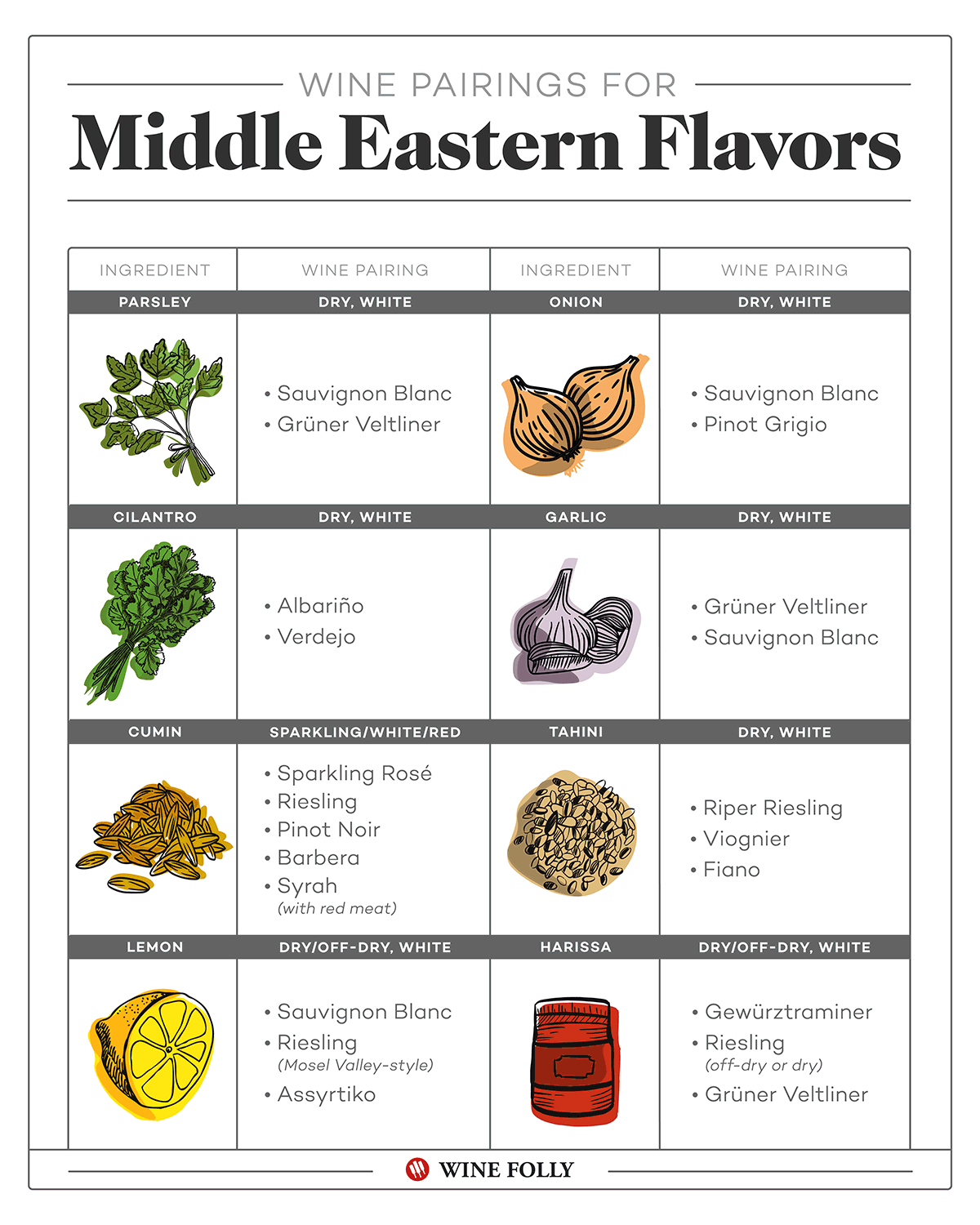
Here you can find the right wines for some of the most common ingredients in Middle Eastern cuisine. Getting to know these ingredients will familiarize you with Middle Eastern food. Plus, it will help you to create complementary dishes of your own:
- Parsley: herbaceous whites with acidity: Sauvignon Blanc, Grüner Veltliner
- Onion: crisp white wines: Sauvignon Blanc, Pinot Grigio
- Cilantro: aromatic whites with acidity: Albariño, Verdejo
- Garlic: herbaceous whites with acidity: Grüner Veltliner, Sauvignon Blanc
- Cumin: refreshing whites, sparkling whites or earthy reds: sparkling rosé, Riesling, Pinot Noir, Barbera, Syrah (with red meat)
- Tahini (sesame paste): aromatic or nutty whites: riper Riesling, Viognier, Fiano
- Lemon: citrusy whites with high acidity: Sauvignon Blanc, Riesling (Mosel Valley style), Assyrtiko
- Harissa (chili paste with spices): dry or off-dry aromatic whites: Gewürztraminer, off-dry or dry Riesling, Grüner Veltliner
9 Amazing Middle Eastern Food and Wine Pairings
The Middle-East and North Africa have a long history of winemaking in Lebanon, Israel, Turkey, Algeria, Morocco, and Tunisia.
These countries make delicious wines of their own that pair wonderfully with their cuisine. And as good as they are, they can be hard to come by outside of their borders. So we’ve put together 9 delicious pairings of Middle Eastern food and more commonly found wine below.
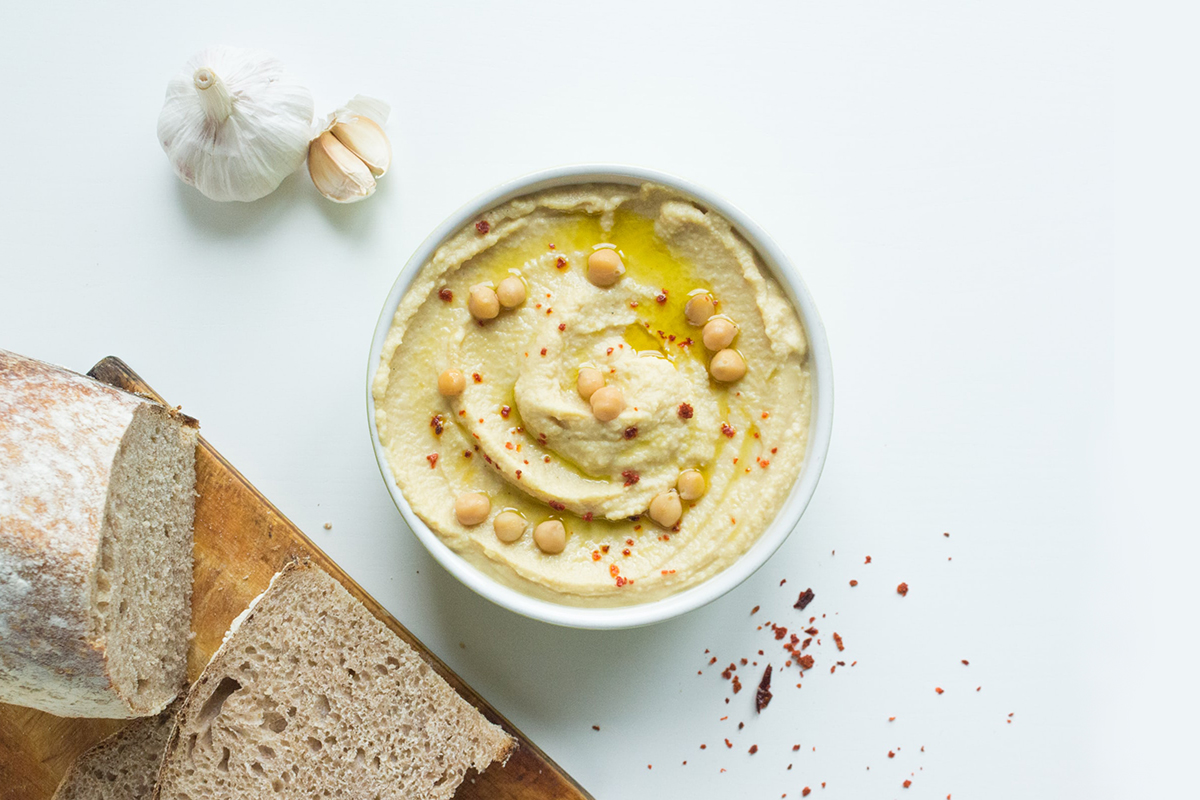
Hummus
The wine you should pair with hummus depends on the flavor of the hummus and what it’s accompanying.
Classic Hummus
Try medium-bodied dry rosé wine or an aromatic, fresh white like Albariño or Assyrtiko.
Why It Works: The acidity in crisp whites like Albariño softens the garlic in the hummus and cuts through the creaminess. On the other hand, rosé wines with some roundness match the hummus’ creamy texture and refresh the palate.
Italian Herb Hummus
Pair with herbaceous reds like Sangiovese or Barbera.
Why It Works: Thyme and rosemary complement the herbal notes of oregano and dried herbs in Sangiovese and Barbera. It’s best to avoid high levels of alcohol that could overpower the flavors of the hummus.
Red Bell Pepper Hummus
Try earthy reds like Pinot Noir and Loire-style Cabernet Franc.
Why It Works: Roasted red pepper develops a slightly sweet, earthy flavor that pairs well with Pinot Noir and Cabernet Franc’s fruity and earthy character.
Spicy Hummus
Pair with off-dry, aromatic whites like Gewurztraminer and Riesling.
Why It Works: The sugar and colder temperature of Gewürztraminer and Riesling help alleviate the tongue, while the aroma enhances the flavor.
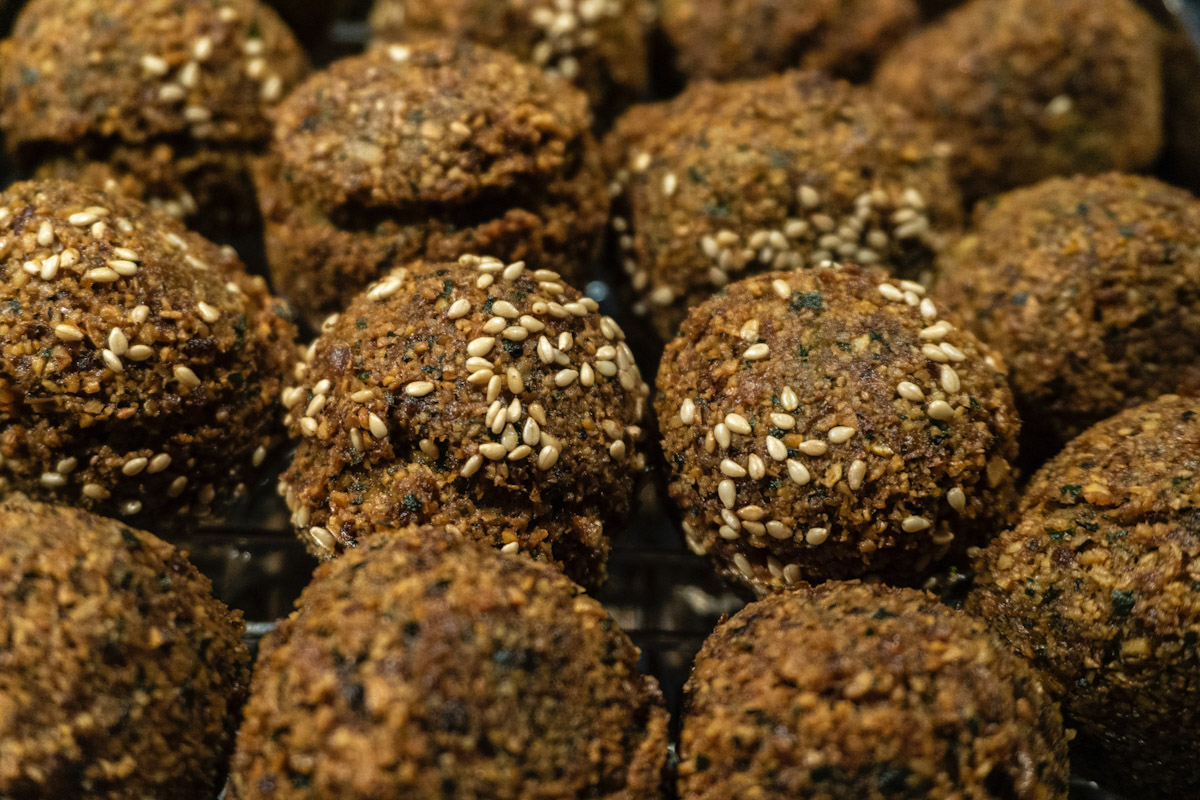
Falafel
The next time you have Falafel, try it with fruity whites with roundness such as Grenache Blanc or Viognier and refreshing whites like Sauvignon Blanc.
Why It Works: The herbaceous/acidity combination in Sauvignon Blanc is great for complementing the garlic and spices of the falafel as well as the herbs and vegetables in a falafel sandwich. The acidity also helps to balance the saltiness.
Riper whites with stone-fruit flavors match well with falafel served with creamy sauces like tahini, where the texture is congruent.

Tabbouleh/Tabouli
Depending on the style and ingredients of this vegan salad, you should adapt your wine pairing accordingly.
Try herbaceous and citrusy whites like Sauvignon Blanc, Riesling, or Gruner Veltliner.
Why It Works: You need a high-acid white to stand up to the lemon juice and tomatoes’ acidity, which will also calm the garlic. The onion and parsley beautifully complement the herbal aromas in the wine.
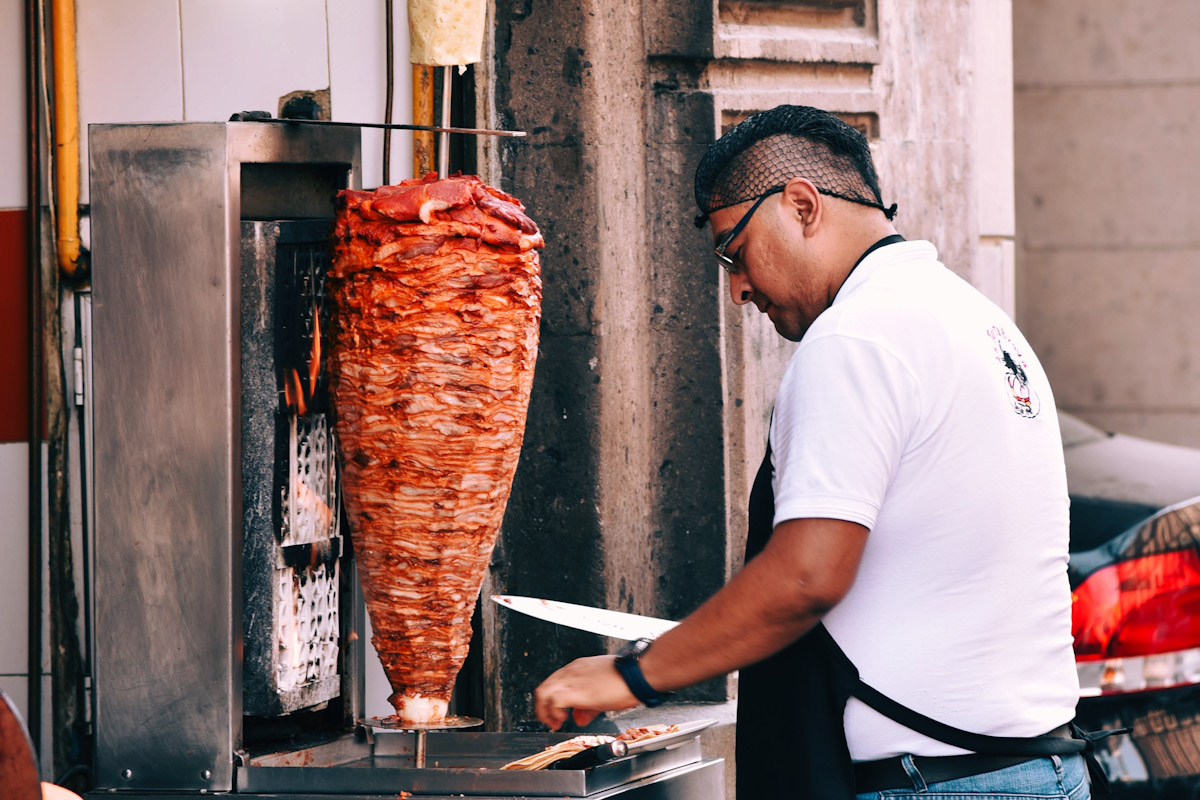
Kebab & Gyro Sandwiches
These classics cover a lot of flavors, so several wines work with them. Start with sparkling whites and dark-fruit reds such as Malbec, Cabernet Sauvignon, and Tempranillo.
Why It Works: These two categories of wine couldn’t be more different, but enhance the kebab equally. As kebabs tend to be salty and greasy, sparkling white wines are a refreshing choice.
They cut through the fat and balance the salt while still providing a refreshing pairing for the onions, herbs, and Tzatziki.
As for dark-fruit reds, the tannins in the wine will cut through the fat in the meat. Plus, the fruit will bring out the spices and rotisserie flavors.
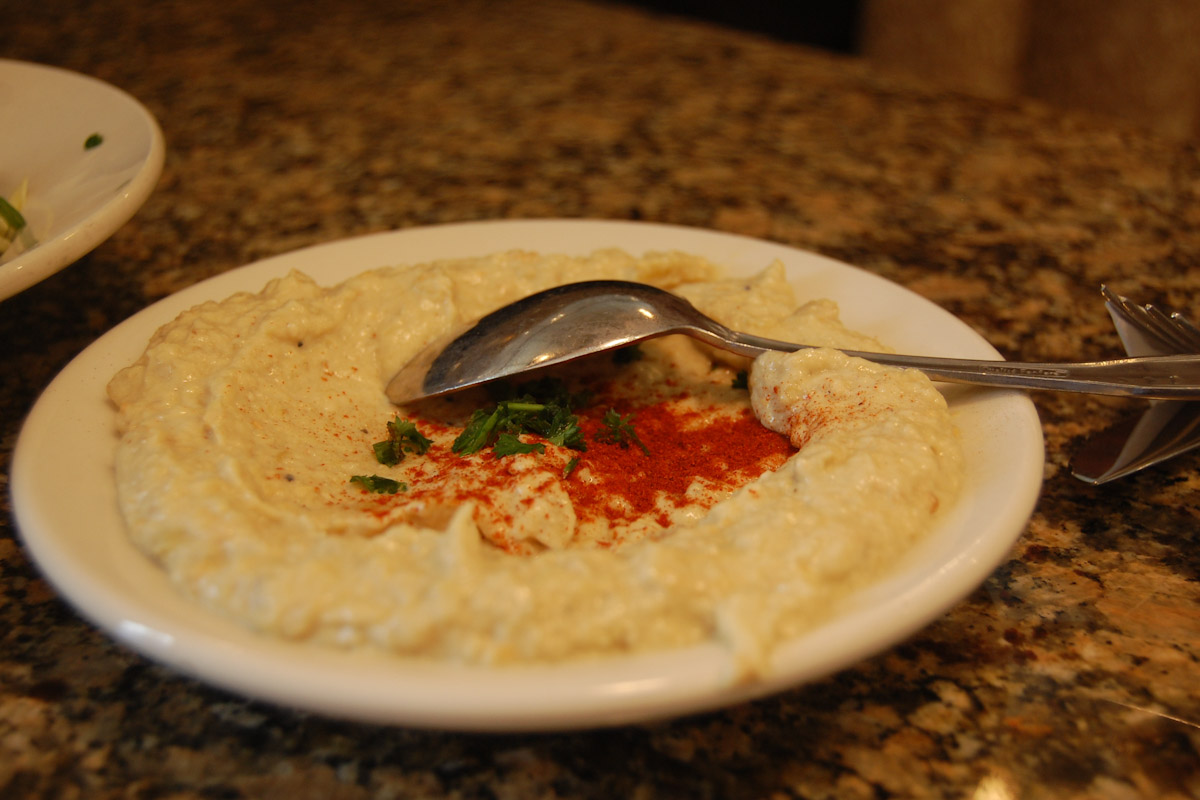
Baba Ghanoush
Crisp and acidic whites pair beautifully with this eggplant dish. Try Pinot Grigio, Assyrtiko, Sauvignon Blanc, Provençal-style rosé, and fruity reds like Primitivo and Negroamaro or Syrah for its smoky, peppery flavors.
Why It Works: The bright acidity and citrus flavors in Assyrtiko provide a nice contrast to the creamy purée while complementing the garlic, pomegranate, and lemon in the salad.
The smokiness of Syrah accentuates the smoky flavors of the grilled eggplant, but you’ll want to make sure the alcohol isn’t too high and the tannins are smooth as not to overpower the dish. When in doubt, Provençal-style rosé has both acidity and fruitiness.

Baklava/Baqlawa
The sweetness of this dessert goes perfectly with sweet white wines such as Sauternes, late harvest Gewürztraminer, sweet Muscat, as well as sweet sparkling wines like doux Champagne.
Why It Works: Baklava tends to be very sweet. As a general rule of thumb, you’ll want to make sure the wine is at least as sweet or sweeter than the Baklava. The sugar in the dessert will lessen the perception of sweetness in the wine.
For more intensely flavored Baklava such as those with spices, orange blossom, or rose water, a sweet Gewürztraminer will match the intensity and enhance aromatic flavors with its notes of rose and lychee.
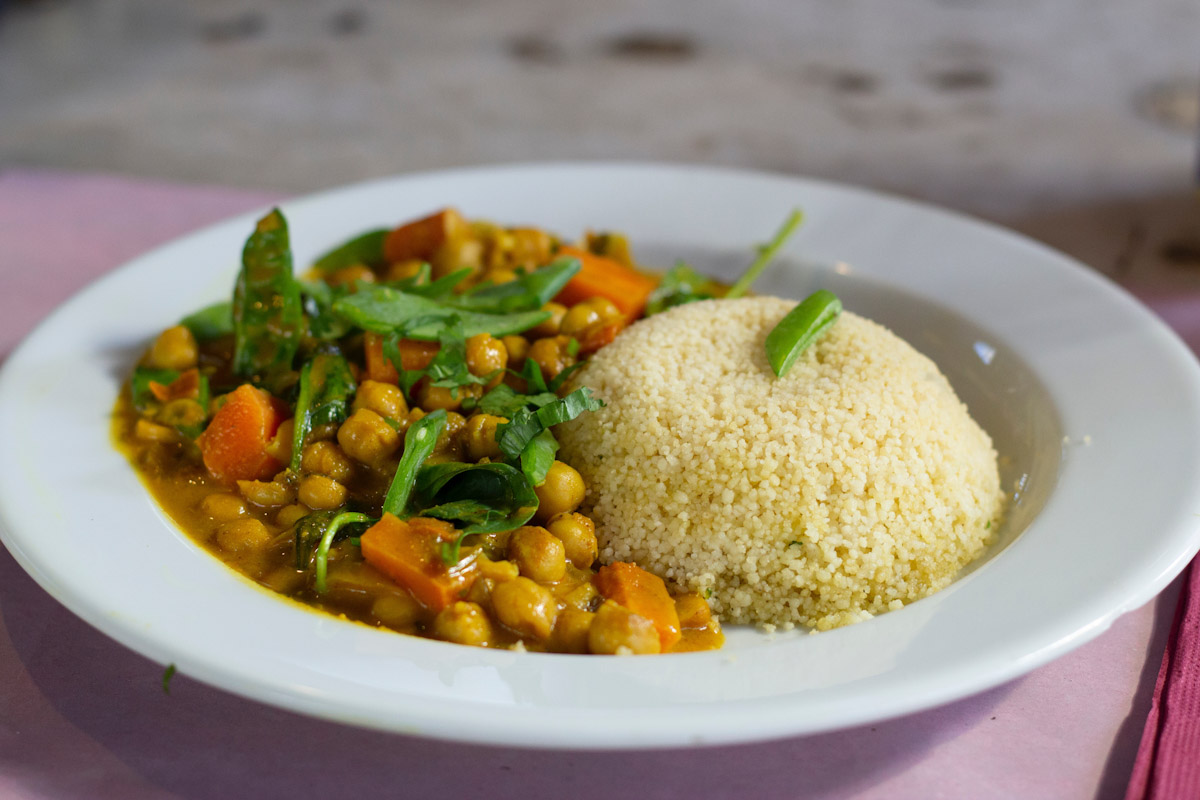
Couscous
The perfumed broth of couscous pairs well with off-dry, aromatic whites such as Riesling, Pinot Gris, or Gewürztraminer; fruity or floral rosé wines from Tavel or Faugères (Grenache, Syrah, Mourvedre etc.); and fruity, herbaceous reds similar to Côtes du Rhône, Barbera, Grenache, or Zinfandel.
Why It Works: For couscous with sweet and spicy elements like those containing caramelized onions, raisins, or chili paste, the sugar in an off-dry white will match the sweetness of the dish, while the aromas in a white such as Riesling will be able to stand up to the aromas in the broth.
Riper rosé wines with fruity and floral aromas are a refreshing pairing with red meat, chicken, or vegetarian couscous, complementing the dish’s spices.
Lastly, fruit-forward reds, especially with lamb or beef couscous, will cut through the fat of the meat with their tannins. And they’ll also complement the spices and aromas with their fruity and herbaceous character.

Tzatziki/Cacik
This fresh white sauce goes great with fresh white wine like Assyrtiko, Sauvignon Blanc, and Trebbiano. It also works with fruity, earthy reds like Cabernet Franc or Pinot Noir when pairing with red meat.
Why It Works: Assyrtiko and Sauvignon Blanc soften the raw garlic with their dry acidity and enhance the herbal and cucumber aromas from the dip.
When pairing with grilled red meats, the fruity aromas complement the grilled flavors in the meat while the earthiness pairs well with the herbs and cucumber in the Tzatziki.
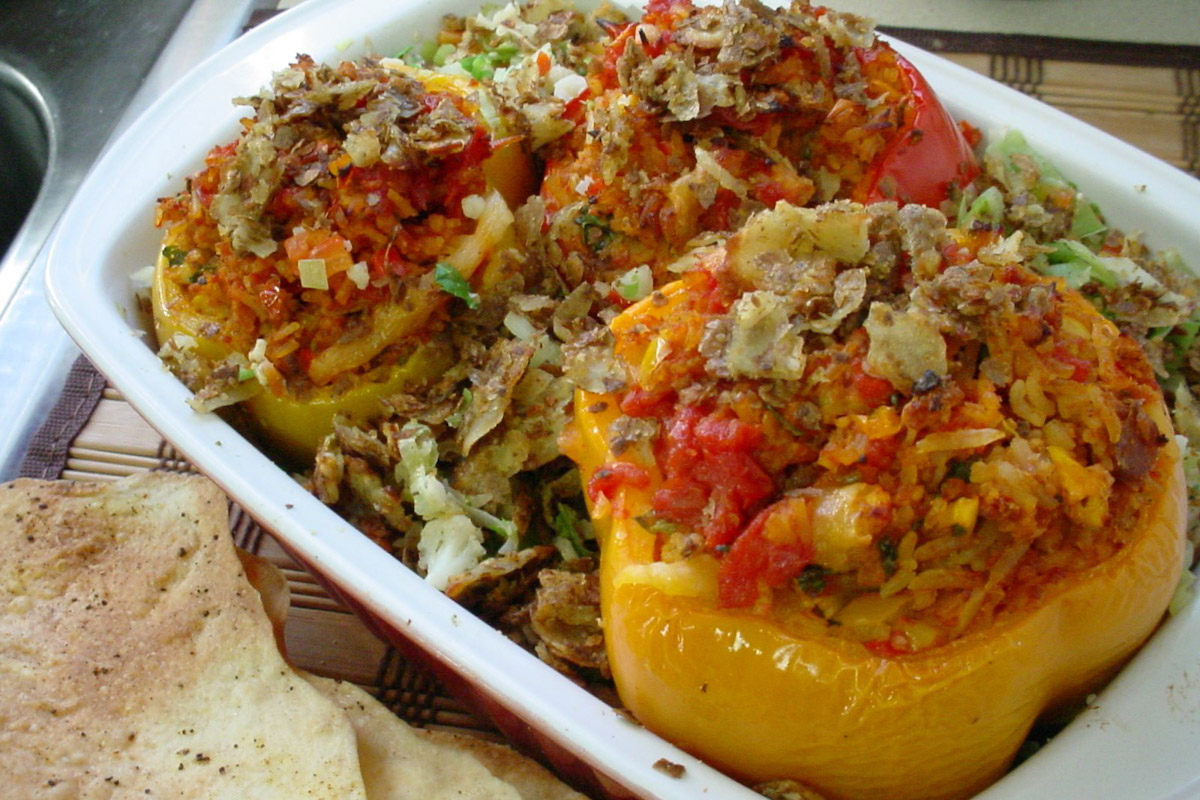
Stuffed Peppers
For stuffed peppers, try fuller-bodied rosé wine such as those from Bandol, fruity reds with light to medium tannins like Barbera or Primitivo, peppery or herbaceous reds such as Cabernet Franc, Syrah, or Sangiovese (with red meat).
Why It Works: Tomatoes lose much of their acidity during the cooking of this dish. As a result, a fruity red like Barbera will match the acidity and complement the sweetness with its fruity character without overpowering the dish with its tannins. Furthermore, the black pepper and herbs in Barbera will enhance the herbs in the dish.
A southerly rosé wine like Bandol will provide fruitiness, an herbal character, as well as roundness to match the hardy nature of the dish while still remaining refreshing.
When pairing with red meat, Syrah will bring a pepperiness, Cabernet Franc notes of capsicum, and Sangiovese flavors of roasted tomato and oregano to provide a balanced pairing in intensity, aromas, and tannins.
Blending Cultures with Wine Pairings
Pairing Middle Eastern food with wine can be a truly multicultural experience. No food duo should be intimidating when you see that the foods of Turkey, Lebanon, and many other countries blend with the wines of France, Italy, and beyond.
Get out there and try some of your own pairings! What have you come up with? What are some of your favorites?